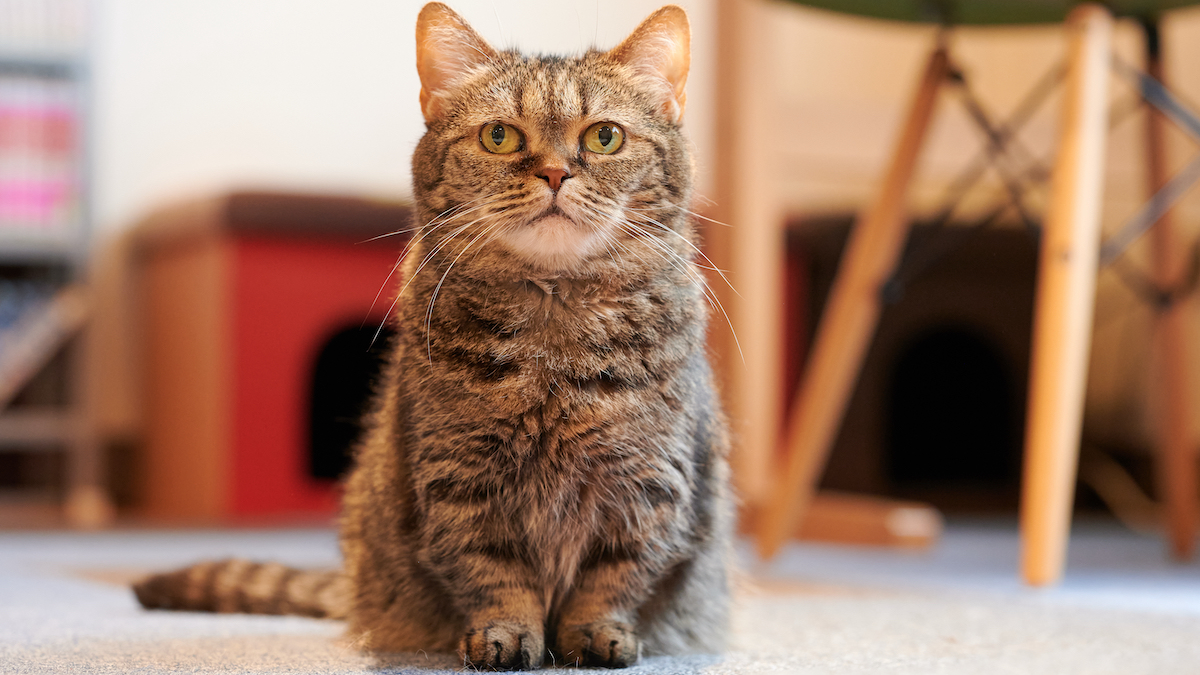Understanding cat allergies

Cat allergies are a common concern for people who love felines but are unfortunately sensitive to them. Allergies to cats are primarily caused by the allergenic proteins found in their saliva, urine, and dander (dead skin flakes). When these proteins come into contact with a person who is allergic, they can trigger symptoms such as sneezing, itchy eyes, runny nose, and even asthma attacks.
One important thing to note is that cat allergies are not caused by the cat's hair itself. While some people may be allergic to specific proteins found in cat hair or saliva, the majority of cat allergies stem from exposure to these allergens in the environment.
It's also worth mentioning that different individuals can have varying levels of sensitivity to cat allergens. Some people may experience mild symptoms with minimal exposure, while others may have more severe reactions that require medical intervention.
To determine whether someone is allergic to cats, it is best to consult with an allergist who can conduct tests like skin prick tests or blood tests. These tests can help identify specific allergens and provide guidance on managing allergies effectively.
If someone discovers they have a cat allergy but still want to enjoy the companionship of a feline friend, there are options available. Hypoallergenic cat breeds are known for producing fewer allergenic proteins and can therefore be considered allergy-friendly.
However, it's crucial to understand that hypoallergenic cats do not guarantee an allergy-free experience for everyone. Every individual's allergy sensitivities are unique, so what works for one person may not work for another. It's essential to spend time with hypoallergenic cats before making a commitment to ensure compatibility.
In addition to hypoallergenic breeds, there are other factors that can affect the level of allergens present in a home. Regular grooming of the cat and maintaining good indoor air quality through proper ventilation and cleaning practices can help reduce the overall allergen load.
Understanding cat allergies is essential for making an informed decision about living with an allergy-friendly cat. By being aware of the allergenic proteins and their sources, individuals can take necessary precautions to manage their symptoms effectively. With the right knowledge and preparation, it is possible to find a feline companion that fits your needs while minimizing allergy-related issues.
Hypoallergenic cat breeds

Hypoallergenic cat breeds are often sought after by individuals who have allergies but still want to enjoy the companionship of a feline friend. These breeds are known for producing fewer allergenic proteins, making them a potential option for people with allergies. While hypoallergenic cats may not completely eliminate all allergy symptoms, they can help minimize the triggers that cause reactions.
One popular hypoallergenic cat breed is the Sphynx. The Sphynx is hairless, which means that it produces less dander and saliva proteins that typically trigger allergic reactions. However, it's important to note that even without fur, the Sphynx still produces some allergens, so individuals with severe allergies might still experience symptoms when exposed to this breed.
Another hypoallergenic option is the Balinese. Despite its silky long coat, the Balinese breed produces significantly fewer allergenic proteins compared to other cats. This breed's low allergen levels can make them more tolerable for individuals with sensitivities to cat allergens.
The Russian Blue is another hypoallergenic breed known for producing fewer allergens. Their short and dense coat tends to trap most of the allergens close to their skin, reducing their presence in the environment. This can be beneficial for allergy sufferers who are especially sensitive to airborne allergens.
The Devon Rex is a breed with curly or wavy hair and minimal shedding. Their unique coat structure tends to hold on to loose hairs and dander, reducing its ability to spread throughout the home. This can result in decreased exposure to allergens and potentially fewer allergy symptoms.
While these are just a few examples of hypoallergenic cat breeds, it's important to keep in mind that individual sensitivity and allergies can vary greatly from person to person. What works for one individual may not work for another. Therefore, spending time with different breeds before making a commitment is crucial in determining compatibility.
It's also important to note that grooming plays a significant role in managing cat allergies. Regular brushing and bathing of hypoallergenic cats help to remove loose hair and dander, further reducing the presence of allergens in the environment.
In conclusion, hypoallergenic cat breeds can be a potential solution for individuals with allergies who want to enjoy the companionship of a feline. While no cat breed is completely allergy-free, hypoallergenic breeds produce fewer allergenic proteins, making them more suitable for individuals with sensitivities. However, personal compatibility and individual reactions should always be considered before bringing an allergy-friendly cat into the home.
Researching allergy-friendly cats

When it comes to finding an allergy-friendly cat, thorough research is essential. There are several factors that you should consider before bringing a feline friend into your home.
Firstly, it's important to understand that no cat breed is completely hypoallergenic. However, some breeds produce fewer allergenic proteins than others, which can make them more suitable for individuals with allergies. Researching these hypoallergenic breeds can help you narrow down your options and find the best fit for your needs.
Start by gathering information about different cat breeds known for being allergy-friendly. Look up their characteristics, coat type, grooming requirements, and overall temperament. This will give you an idea of what to expect when living with a particular breed and how compatible it may be with your allergies.
In addition to breed-specific research, it's crucial to learn about individual cats. Within each breed, there can be variations in allergen levels and individual personality traits that may affect your compatibility. Consider reaching out to reputable cat breeders or animal shelters that specialize in hypoallergenic cats. They can provide valuable insights into specific cats' allergen levels and temperament.
Reading reviews and testimonials from other allergy sufferers who have owned cats of specific breeds can also be beneficial. It can give you an understanding of their experiences and whether they found relief from their allergies by living with an allergy-friendly cat.
You may also want to consult with an allergist before making a decision. They can perform specific tests to identify whether you are allergic to certain cat breeds or not. This information will further guide your research and help you narrow down your choices based on your personal sensitivities.
Lastly, don't forget to consider the availability of allergy-friendly cats in your area. Research local breeders, rescues, or shelters that specialize in hypoallergenic cats and check if they have any available for adoption.
By conducting thorough research on both the breed and individual cats within those breeds, you can make an informed decision and find an allergy-friendly cat that best suits your needs. Remember, everyone's allergies are different, so what may work for one person may not work for another. Taking the time to research and gather information will ultimately help you find the perfect feline companion while minimizing your allergy symptoms.
Visiting breeders and shelters

When it comes to finding an allergy-friendly cat, visiting breeders and shelters can be a crucial step in your research process. Visiting these places allows you to gather firsthand information about the cats available and interact with them to assess their compatibility with your allergies.
Breeders who specialize in hypoallergenic cats can provide valuable insights into the specific breeds they work with. They can inform you about the allergen levels of the cats they breed, as well as any specific characteristics or temperament traits that may be important to consider. Visiting a breeder also gives you the opportunity to see how the cats are raised and cared for, which is essential for ensuring the health and wellbeing of your potential feline companion.
Shelters that focus on hypoallergenic cat breeds are another great resource to explore. These shelters often have a variety of cats available for adoption, allowing you to meet different individuals within the same breed and assess their compatibility with your allergies. Shelters usually have staff members who can provide information about each cat's background, behavior, and any known allergies they may have. By interacting with these cats during a shelter visit, you can get a sense of their personality and see if they trigger any allergic reactions.
During your visits to breeders or shelters, don't hesitate to ask questions. Inquire about the living conditions of the cats, any measures taken to reduce allergens in the environment, and if there have been previous cases where allergic individuals successfully adopted from them. Take note of any noticeable reactions you experience while spending time with the cats.
Additionally, consider bringing along someone else who doesn't have allergies to help assess behaviors or reactions that may not be immediately apparent to you.
Remember that while visiting breeders and shelters is an important step in your search for an allergy-friendly cat, it shouldn't be rushed. Take your time observing different cats and interacting with them before making a decision. Also, be sure to follow any guidelines or protocols set by the breeder or shelter to ensure the well-being of their cats.
By visiting breeders and shelters, you can gain valuable insights into allergy-friendly cat breeds and find an individual cat that best fits your needs. These visits provide an opportunity for personal assessment, allowing you to gauge your compatibility with different cats before making a final decision.
Considerations for living with an allergy-friendly cat

Living with an allergy-friendly cat requires careful consideration to ensure your health and the well-being of your feline companion. Although cats that are considered hypoallergenic produce fewer allergens, it is essential to understand that these breeds may not be completely allergen-free. Here are some key considerations to keep in mind when living with an allergy-friendly cat:
- Allergy testing: Before bringing home an allergy-friendly cat, it's crucial to undergo allergy testing to confirm that you are allergic to cats specifically and not other allergens. This will help you determine if owning a cat is a suitable choice for you.
- Regular grooming: Allergy-friendly cats may still produce some allergens, such as dander or saliva, albeit in reduced amounts. To minimize exposure to these allergens, regular grooming of your cat is necessary. Frequent brushing can help remove loose fur and reduce the amount of allergens present on your cat's coat.
- Clean living environment: Maintaining a clean living environment is vital when living with an allergy-friendly cat. Regularly vacuuming carpets and furniture, using air purifiers, and keeping bedding clean can help reduce the presence of allergens in your home.
- Proper ventilation: Ensuring proper ventilation in your home can also aid in reducing airborne allergens. Opening windows for fresh air circulation and using exhaust fans can help remove allergens from the indoor environment.
- Establishing off-limit areas: Designating certain areas of your home as off-limits for your cat can provide you with a safe space where you can limit exposure to allergens. For example, keeping your bedroom door closed can create a sanctuary free from potential triggers.
- Personal allergies management: Along with managing the living environment, it's important to take steps to manage your personal allergies as well. This may include taking prescribed medications or using antihistamines during periods of increased sensitivity.
Remember, each person's allergy symptoms and sensitivities may vary. It is recommended to consult with a healthcare professional or allergist for personalized advice on managing your allergies while living with an allergy-friendly cat.
By considering these factors and taking necessary precautions, you can create a harmonious and comfortable living arrangement with your allergy-friendly cat. It's important to note that it may take some time for your body to adjust to a new cat even if it is considered hypoallergenic. Patience, communication, and proactive care are key in maintaining a healthy and happy relationship with your feline companion.
Tips for managing cat allergies

Living with allergies can be challenging, but with the right strategies and precautions, it is possible to manage cat allergies while still enjoying the love and companionship of a feline friend. Here are some practical tips for managing cat allergies:
- Keep your home clean: Regularly vacuuming carpets, furniture, and curtains can help remove allergens such as dander and fur from your living environment. Using a vacuum cleaner with a HEPA (high-efficiency particulate air) filter is even more effective in trapping allergens.
- Create an allergy-friendly zone: Designate certain areas in your home as off-limits for your cat. For example, keep your bedroom door closed to create a sanctuary where you can minimize exposure to allergens while you sleep.
- Use hypoallergenic bedding: Invest in hypoallergenic bedding covers that can act as a barrier against allergens like dust mites and pet dander. These covers are easy to clean and can significantly reduce allergic reactions.
- Install an air purifier: An air purifier with a HEPA filter can help remove airborne allergens from your home, improving air quality and reducing your exposure to cat allergens.
- Wash hands frequently: Washing hands after playing or cuddling with your cat can help remove any residual allergens on your skin.
- Avoid touching your face: Avoid touching your face, especially around the eyes, nose, and mouth, as this can transfer allergens from your hands to these sensitive areas.
- Bathe your cat regularly: While most cats groom themselves adequately, regular bathing can help minimize dander production and reduce the amount of allergens on their fur.
- Consider allergy medications or treatments: Consult with an allergist or healthcare professional about allergy medications or treatments that may help alleviate symptoms related to cat allergies.
- Maintain good ventilation: Proper ventilation in your home is important for minimizing airborne allergens. Open windows for fresh air circulation and use exhaust fans in kitchens and bathrooms to remove allergens.
- Consult with a professional: If your allergies are severe, consider consulting with an allergist who can provide personalized advice and recommendations for managing your specific allergies while living with a cat.
Remember, managing cat allergies is all about reducing exposure to allergens and maintaining a clean living environment. By implementing these tips and taking necessary precautions, you can create a more allergy-friendly home and enjoy the company of an allergy-friendly cat.
Conclusion: Finding the perfect allergy-friendly cat

Finding the perfect allergy-friendly cat can be a challenging task, but with careful research and consideration, it is possible to find a feline companion that fits your needs. Understanding cat allergies and knowing which cat breeds are considered hypoallergenic is key to narrowing down your options.
When researching allergy-friendly cats, it is important to gather as much information as possible about their specific characteristics and how they interact with allergens. Look for cats that produce less dander, as this is a common trigger for allergies. Additionally, consider their grooming habits and whether they are prone to excessive shedding.
Visiting breeders and shelters is another important step in finding an allergy-friendly cat. Take the time to meet and interact with different cats to see how your body reacts. Observe any allergic symptoms that may arise, such as sneezing, itching, or difficulty breathing. Pay attention to the cat's behavior and temperament as well, ensuring that their personality aligns with what you are looking for in a pet.
Living with an allergy-friendly cat requires taking certain precautions. Keep your home clean by regularly vacuuming and dusting to minimize the presence of allergens. Create designated areas where your cat is not allowed access, such as bedrooms or other sleeping spaces. Consider using hypoallergenic bedding covers to create an extra barrier against allergens.
Investing in an air purifier with a HEPA filter can greatly improve air quality by removing airborne allergens. This can significantly reduce allergic reactions and symptoms. Regularly washing hands after handling your cat and avoiding touching your face will also help minimize exposure to allergens.
If needed, consult with an allergist or healthcare professional about allergy medications or treatments that may alleviate symptoms related to cat allergies. They can provide personalized advice and recommendations based on your specific allergies.
In conclusion, finding an allergy-friendly cat requires patience and thorough research. By understanding your allergies, researching hypoallergenic breeds, visiting breeders and shelters, and implementing necessary precautions, you can find the perfect allergy-friendly cat that will bring joy and companionship to your life without causing excessive allergic reactions. Remember to prioritize your health and well-being while still enjoying the love of a feline friend.




0 Comments